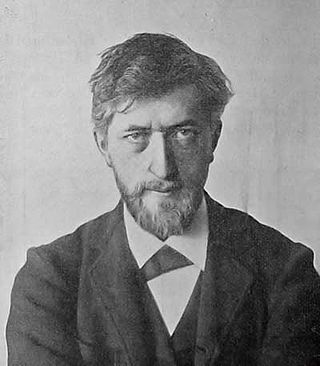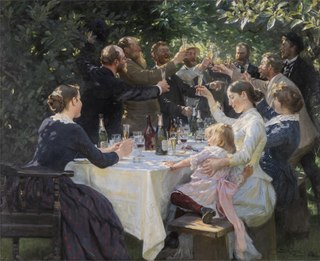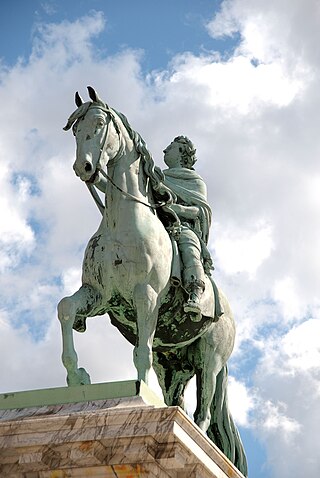
Max Ernst was a German painter, sculptor, printmaker, graphic artist, and poet. A prolific artist, Ernst was a primary pioneer of the Dada movement and Surrealism in Europe. He had no formal artistic training, but his experimental attitude toward the making of art resulted in his invention of frottage—a technique that uses pencil rubbings of textured objects and relief surfaces to create images—and grattage, an analogous technique in which paint is scraped across canvas to reveal the imprints of the objects placed beneath. Ernst is noted for his unconventional drawing methods as well as for creating novels and pamphlets using the method of collages. He served as a soldier for four years during World War I, and this experience left him shocked, traumatised and critical of the modern world. During World War II he was designated an "undesirable foreigner" while living in France.

Albert Bertel Thorvaldsen was a Danish and Icelandic sculptor and medalist of international fame, who spent most of his life (1797–1838) in Italy. Thorvaldsen was born in Copenhagen into a working-class Danish/Icelandic family, and was accepted to the Royal Danish Academy of Art at the age of eleven. Working part-time with his father, who was a wood carver, Thorvaldsen won many honors and medals at the academy. He was awarded a stipend to travel to Rome and continue his education.

The Ny Carlsberg Glyptotek, commonly known simply as Glyptoteket, is an art museum in Copenhagen, Denmark. The collection represents the private art collection of Carl Jacobsen (1842–1914), the son of the founder of the Carlsberg Breweries.

Georg Arthur Jensen was a Danish silversmith and founder of Georg Jensen A/S.
Per Kirkeby was a Danish painter, poet, film maker and sculptor. His works have been exhibited worldwide and are represented in many important public collections, including the Tate, Metropolitan Museum of Art, Museum of Modern Art, and the Centre Pompidou.

The Danish Golden Age covers a period of exceptional creative production in Denmark, especially during the first half of the 19th century. Although Copenhagen had suffered from fires, bombardment and national bankruptcy, the arts took on a new period of creativity catalysed by Romanticism from Germany. The period is probably most commonly associated with the Golden Age of Danish Painting from 1800 to around 1850 which encompasses the work of Christoffer Wilhelm Eckersberg and his students, including Wilhelm Bendz, Christen Købke, Martinus Rørbye, Constantin Hansen and Wilhelm Marstrand, as well as the sculpture of Bertel Thorvaldsen.

The National Gallery of Denmark is the Danish national gallery, located in the centre of Copenhagen.

Jens Ferdinand Willumsen was a Danish painter, sculptor, graphic artist, architect and photographer. He became associated with the movements of Symbolism and Expressionism.

Per Arnoldi is a Danish designer and artist. He has worked with many media, including painting, sculptures, ceramics and posters and has made designs for many companies, organisations and institutions, doing air planes, train stations, hospitals, architecture, monuments, stores, company profiles, handicrafts and everyday utensils. His characteristic simplistic expressions are often categorized as modern art. Arnoldi has worked in many countries around the world and is on permanent exhibit in several prestigious art and design institutions for his unique and influential productions, including Museum of Modern Art in New York.

Janus Kamban was a Faroese sculptor and last living representative from the "first generation" of professional artists in the Faroe Islands.

Danish art is the visual arts produced in Denmark or by Danish artists. It goes back thousands of years with significant artifacts from the 2nd millennium BC, such as the Trundholm sun chariot. For many early periods, it is usually considered as part of the wider Nordic art of Scandinavia. Art from what is today Denmark forms part of the art of the Nordic Bronze Age, and then Norse and Viking art. Danish medieval painting is almost entirely known from church frescos such as those from the 16th-century artist known as the Elmelunde Master.

The Hirschsprung Collection is an art museum located on Stockholmsgade in Copenhagen, Denmark. It is located in a parkland setting in Østre Anlæg, near the Danish National Gallery, and houses a large collection of Danish art from the 19th and early 20th century. The emphasis is on the Danish Golden Age, from 1800 to 1850, but also the Skagen Painters and other representatives of the Modern Breakthrough are well represented.

Bjørn Nørgaard is a Danish artist who has been active in a variety of fields. He has significantly influenced the art scene in Denmark both through his "happenings" and his sculptures in Danish cities. Although he has specialized in sculpture since 1970, his greatest achievement is perhaps his work in designing Queen Margrethe II's tapestries. Nørgaard was a professor at the Royal Danish Academy of Fine Arts from 1985 to 1994. His main workshop is in the village of Bissinge on the island of Møn.
Keld Helmer-Petersen was a Danish photographer who achieved widespread international recognition in the 1940s and 1950s for his abstract colour photographs.

The Skagen Painters were a group of Scandinavian artists who gathered in the village of Skagen, the northernmost part of Denmark, from the late 1870s until the turn of the century. Skagen was a summer destination whose scenic nature, local milieu and social community attracted northern artists to paint en plein air, emulating the French Impressionists—though members of the Skagen colony were also influenced by Realist movements such as the Barbizon school. They broke away from the rather rigid traditions of the Royal Danish Academy of Fine Arts and the Royal Swedish Academy of Arts, espousing the latest trends that they had learned in Paris. Among the group were Anna and Michael Ancher, Peder Severin Krøyer, Holger Drachmann, Karl Madsen, Laurits Tuxen, Marie Krøyer, Carl Locher, Viggo Johansen and Thorvald Niss from Denmark, Oscar Björck and Johan Krouthén from Sweden, and Christian Krohg and Eilif Peterssen from Norway. The group gathered together regularly at the Brøndums Hotel.

Danish sculpture as a nationally recognized art form can be traced back to 1752 when Jacques Saly was commissioned to execute a statue of King Frederick V of Denmark on horseback. While Bertel Thorvaldsen was undoubtedly the country's most prominent contributor, many other players have produced fine work, especially in the areas of Neoclassicism, Realism, and in Historicism, the latter resulting from growing consciousness of a national identity. More recently, Danish sculpture has been inspired by European trends, especially those from Paris, including Surrealism and Modernism.

Jørgen Haugen Sørensen was one of Denmark's most eminent sculptors. He had his artistic debut at the acclaimed and prestigious Spring Exhibition (Forårsudstillingen) at Kunsthal Charlottenborg, Copenhagen in 1953. Haugen Sørensen was a member of the artistic union Decembristerne and the artist collective Grønningen, as well as Veksølund in Denmark.

Aksel Jørgensen was a Danish painter and wood engraver. He is also remembered for his years as the director and professor at the Royal Danish Academy where he instructed many Danish illustrators.
Christian Lemmerz is a German-Danish sculptor and visual artist who attended the Accademia di Belle Arti in Carrara, Italy, from 1978 to 1982 and the Royal Danish Academy of Fine Arts from 1983 to 1988. Despite classical sculpture training in Carrara, Lemmerz drew his main inspiration from the post-war process-oriented pop art, not least from his fellow countryman, Joseph Beuys.
John Olsen is a Danish sculptor, illustrator and painter.
















